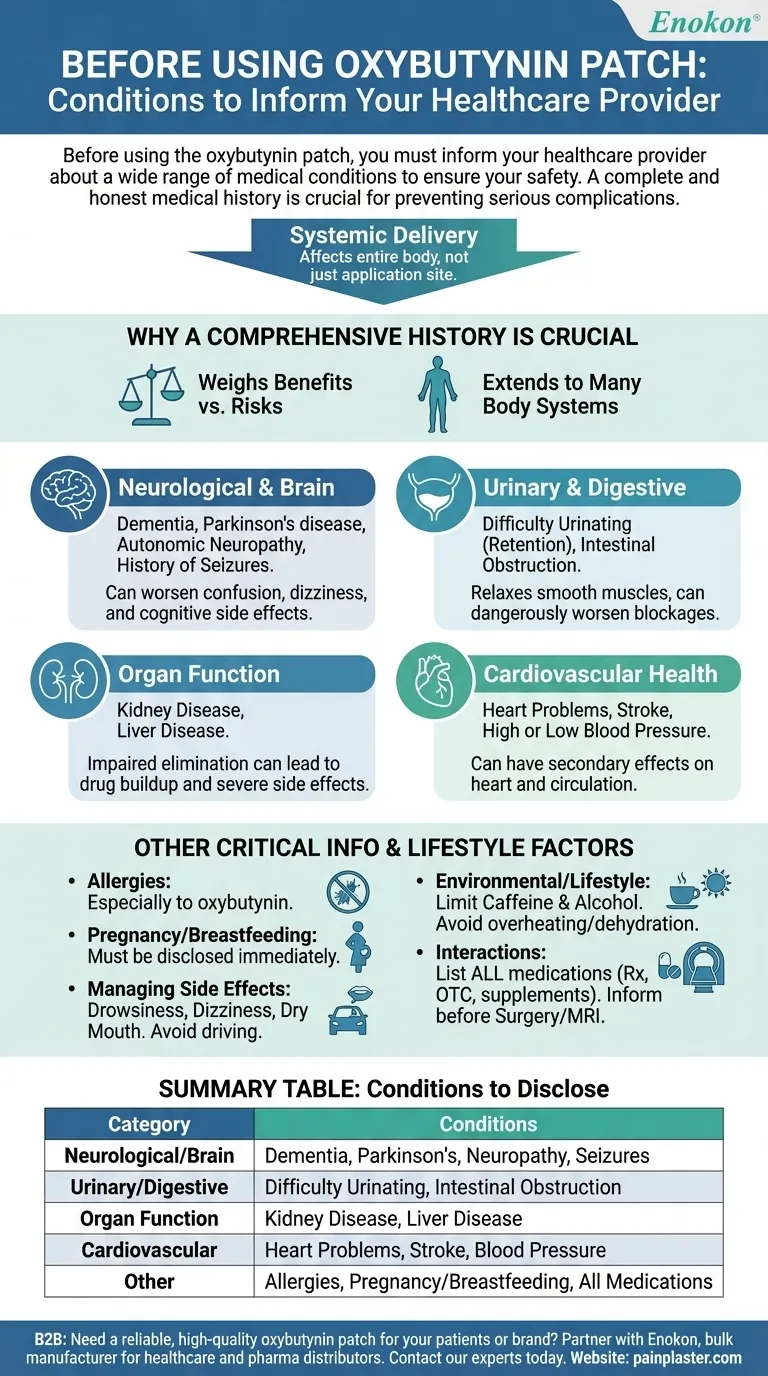Before using the oxybutynin patch, you must inform your healthcare provider about a wide range of medical conditions to ensure your safety. Key conditions include glaucoma, difficulty urinating, intestinal obstruction, kidney or liver disease, myasthenia gravis, dementia, and Parkinson's disease. It is also critical to disclose any allergies, especially to oxybutynin, as well as if you are pregnant, planning a pregnancy, or breastfeeding.
The oxybutynin patch delivers medication systemically, meaning it affects your entire body, not just the application site. Therefore, a complete and honest medical history is the single most important factor in preventing serious complications and ensuring the treatment is appropriate for you.

Why a Comprehensive Medical History is Crucial
Oxybutynin works by relaxing the bladder muscle, but its effects extend to many other systems in the body. Disclosing your full health profile allows your provider to weigh the benefits of the patch against potential risks associated with your specific conditions.
Impact on the Nervous System and Brain
Certain neurological conditions can be significantly worsened by oxybutynin.
Inform your provider if you have dementia, Parkinson's disease, autonomic neuropathy, or a history of seizures. Oxybutynin can sometimes cause or worsen confusion, dizziness, and other cognitive side effects.
Effects on Urinary and Digestive Systems
The primary action of oxybutynin is on smooth muscles, which are found in your bladder and your gut.
It is critical to report any difficulty passing urine (urinary retention) or any history of intestinal obstruction. Because the drug relaxes the bladder, it can make these conditions dangerously worse.
Considerations for Organ Function
Your liver and kidneys are responsible for processing and clearing medication from your body.
If you have liver disease or kidney disease, your body may not be able to eliminate oxybutynin effectively. This can lead to a buildup of the drug, increasing the risk of severe side effects.
Cardiovascular and Circulatory Health
Oxybutynin can have secondary effects on your heart and circulation.
Disclose any history of heart problems, stroke, or high or low blood pressure. Your provider needs this information to ensure the medication will not put undue stress on your cardiovascular system.
Practical Considerations and Safety Measures
Beyond your core medical history, certain lifestyle factors and potential interactions are vital to discuss with your provider to use the patch safely.
Managing Common Side Effects
The most common side effects are often manageable but require awareness.
Oxybutynin frequently causes drowsiness, dizziness, and dry mouth. Avoid driving or operating heavy machinery until you know how it affects you. Chewing sugarless gum or drinking water can help alleviate dry mouth.
Environmental and Lifestyle Factors
Your daily habits and environment can impact the treatment's effectiveness and safety.
Limit your intake of caffeine and alcohol, as these can irritate the bladder and counteract the medication's benefits. The patch can also reduce your ability to sweat, so avoid overheating or becoming dehydrated in hot weather.
Interactions with Other Substances and Procedures
The patch is not an isolated treatment; it interacts with other things you put in your body.
Provide your doctor and pharmacist with a complete list of all medications you use, including prescriptions, over-the-counter drugs, and supplements. Also, inform any medical staff you are using the patch before undergoing surgery or an MRI.
Making the Right Choice for Your Health
Your goal is to get relief from your symptoms safely. Providing a complete picture of your health is the best way to achieve this. Use this checklist before your appointment.
- If you have existing neurological or cognitive conditions: Be aware that oxybutynin can worsen symptoms like confusion, and this must be a primary point of discussion with your doctor.
- If you have urinary, kidney, or digestive issues: Understand that the drug directly impacts these systems, and pre-existing problems could lead to serious complications like a blockage.
- If you have heart or circulatory problems: Your provider must evaluate whether the potential effects on heart rate and blood pressure are an acceptable risk for you.
- If you are pregnant, planning to be, or breastfeeding: This must be disclosed immediately, as the medication may not be suitable.
Ultimately, open communication with your healthcare provider is the foundation of safe and effective treatment.
Summary Table:
| Category | Conditions to Disclose |
|---|---|
| Neurological/Brain | Dementia, Parkinson's disease, autonomic neuropathy, history of seizures |
| Urinary/Digestive | Difficulty urinating (urinary retention), intestinal obstruction |
| Organ Function | Kidney disease, liver disease |
| Cardiovascular | Heart problems, stroke, high or low blood pressure |
| Other Critical Info | Allergies (especially to oxybutynin), pregnancy/breastfeeding status, all other medications |
Need a reliable, high-quality oxybutynin patch for your patients or brand? Partner with Enokon, a bulk manufacturer of reliable transdermal patches and pain plasters for healthcare and pharma distributors and brands. Benefit from our technical expertise for custom R&D and development to create a product that prioritizes patient safety. Contact our experts today to discuss your requirements.
Visual Guide

Related Products
- Far Infrared Heat Pain Relief Patches Transdermal Patches
- Far Infrared Deep Heat Relief Patches Medicated Pain Relief Patches
- Capsaicin Chili Medicated Pain Relief Patches
- Icy Hot Menthol Medicine Pain Relief Patch
- Menthol Gel Pain Relief Patch
People Also Ask
- How quickly does the Deep Heat Pain Relief Back Patch activate and how long does it provide warmth? Get 16-Hour Relief
- How does the Deep Heat Back Patch work? A Drug-Free Solution for Targeted Pain Relief
- What types of pain can the Deep Heat Pain Relief Back Patch be used for? Targeted Relief for Muscles & Joints
- How does capsaicin work in the medicated heat patch? The Science Behind Pain Relief
- What are the key features of the Deep Heat Pain Relief Back Patch? Get Up to 16 Hours of Drug-Free Relief
















